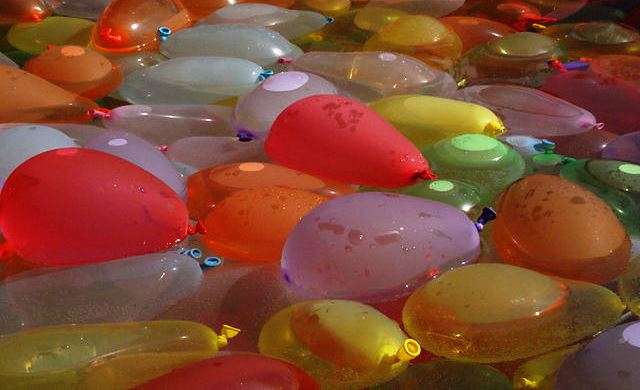Last updated: September 28, 2016
Lesson Plan
H2Oh no! – A Water Balloon Lesson

- Grade Level:
- High School: Ninth Grade through Twelfth Grade
- Subject:
- Science
- Lesson Duration:
- 60 Minutes
- Common Core Standards:
- F.IF.7.c
- State Standards:
- State: Texas
Subject: Science-Physics
Grade Level: 10th
112.39 (b.1, 2, 3, 5) (c.1A-B, 2A-I, 3AF, 4C) (4) History (C) - Additional Standards:
- AP Physics 1:
Newtonian Mechanics
Kinematics
Motion in two dimensions, including projectile motion - Thinking Skills:
- Analyzing: Break down a concept or idea into parts and show the relationships among the parts. Creating: Bring together parts (elements, compounds) of knowledge to form a whole and build relationships for NEW situations.
Objective
Projectiles come in all shapes and sizes. Projectiles are objects with an initial velocity that are only affected by gravity after initial velocity has been obtained. You see projectiles every day – in sports and even dropped from birds. In this lab, you will analyze the physical properties of a water balloon in flight, aka a projectile, over multiple trials.
Background
Looking to improve their artillery, the U.S. Army sent the Major Ringgold to France and England to study their technology. Upon his return, this soldier/innovator redesigned both U.S. field artillery and methods for firing the new cannon. His creation, “Flying Artillery,” was an extremely lightweight cannon that could be quickly moved around the battlefield.
Ringgold, determined his invention would work, drilled his cannoneers. The practice paid off. During the Battle of Palo Alto, Ringgold’s Flying Artillery flew across the battlefield and successfully defended many Mexican attacks.
In contrast, Mexican field artillery was older and heavier their U.S. counterparts. Many pieces were leftover from the Spanish occupation of Mexico. Furthermore, their weight made them slower on the battlefield. Poor black powder rendered these cannon even more ineffective as they had a shorter firing range than the U.S. artillery.
Preparation
- Review the activity.
- Print the student worksheets. Print one for each student or each group of 4-5.
- This is an outdoor activity. Find a spot big enough for a group of 4-6 students to stand across from each other as shown in Diagram #1.
- Students need to fill up water balloons. Determine if this will be done outside or inside.
- Gather all materials. Each group of 4-5 students needs:
- 6 Balloons
- 3 Meter sticks marked with colored tape at every decimeter mark
- 1 Camera (cell phone cameras are OK)
- 1 Meter of colored tape
- 1 Protractor or protractor app
Materials
Use for recording measurements, calculating data, and student assessment.
Download Water Balloon Projectile Lab
Use the answers to the calculations and post-lab questions to assess student learning.
Download Water Balloon Answer Key
Lesson Hook/Preview
Projectiles have been used in combat since the first time a person threw a rock at someone else. During the U.S.-Mexican War, soldiers used projectiles - musket balls and cannon balls.
In this lab, you will analyze the physical properties of a water balloon in flight over multiple trials.
Procedure
Step #1
- Have students get into groups of 4-5.
- Give each group:
- Lab worksheet
- 6 balloons
- One 3-meter stick
- Video camera or device with a video camera
- Tell students to fill the balloons with water until they are about the size of a fist.
Step #2
- Take students outside.
- Put two meter sticks parallel to the ground. Put the other meter stick perpendicular to the ground.
- Tell students to get in the formation shown in Diagram #1.
- The two students throwing balloons need three balloons each.
Step #3
- Throw the balloons back and forth six times, catching it each time.
- Record each of the six throws as a separate recording. For each throw:
- Film the balloon.
- Catch the balloon.
- Use the meter stick to measure the range and height of the balloon.
- Record your observations on the data table.
- When finished, pick up the balloon pieces, gather equipment, and go back to the classroom.
Step #4
- Analyze your observations.
- To determine the angle:
- Watch the balloon’s direction of motion in the first few frames of the video.
- Create a line based on the balloon’s position.
- Use a protractor to measure the angle of the balloon relative to the meter sticks.
- Estimate the displacement on the x-axis (your meter sticks).
- Calculate an average displacement on the x-axis (Δx) and an average angle of release.
- Have students complete the lab worksheet and post-lab questions.
Vocabulary
Projectile - An object that is affected by gravity after its initial velocity has been obtained
